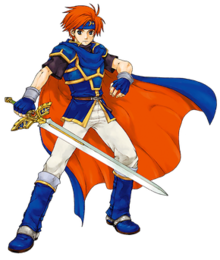Fire Emblem is a Japanese fantasy tactical role-playing game franchise developed by Intelligent Systems and published by Nintendo. First produced and published for the Nintendo Entertainment System in 1990, the series currently consists of seventeen core entries and five spinoffs.

Mr. Game & Watch is a 2D generic stick figure-styled silhouette character, created by Nintendo as an amalgamation of the Game & Watch handheld consoles. He was created by Gunpei Yokoi, with an intention of representing the Game & Watch collection, as the consoles had no main mascot, rather characters designed for the minigames. He debuted in Ball from Game & Watch. Mr. Game & Watch has appeared as a cameo in several other Nintendo games, such as Donkey Kong Country Returns, WarioWare: Touched!, Rhythm Heaven Fever and Super Mario Odyssey.
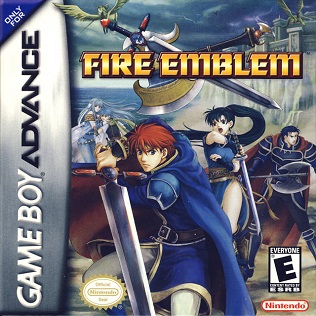
Fire Emblem: The Blazing Blade, also known simply as Fire Emblem, is a tactical role-playing game developed by Intelligent Systems and published by Nintendo for the Game Boy Advance handheld video game console. It is the seventh installment in the Fire Emblem series, the second to be released for the platform after Fire Emblem: The Binding Blade, and the first to be localized for international audiences. It was released in Japan and North America in 2003, and in Europe and Australia in 2004.
Super Smash Bros. is a crossover platform fighting game series published by Nintendo. The series was created by Masahiro Sakurai, who has directed every game in the series. The series is known for its unique gameplay objective which differs from that of traditional fighters, in that the aim is to increase damage counters and knock opponents off the stage instead of depleting life bars.

Ike is a character from the Fire Emblem series of video games. He is the central protagonist and Lord-class character of the ninth game in the series, Fire Emblem: Path of Radiance, and one of the central characters in Fire Emblem: Radiant Dawn. Ike is one of the most popular characters in the Fire Emblem series, and has appeared in other media, most notably the Super Smash Bros. fighting game series.

Fire Emblem: Path of Radiance is a 2005 tactical role-playing video game developed by Intelligent Systems and Nintendo SPD, and published by Nintendo for the GameCube. It is the ninth main installment in the Fire Emblem series, and the third to be released in the west. As with previous installments, gameplay revolves around positioning characters on a battlefield to defeat an opposing force. If characters are defeated in battle, they are removed from the rest of the game.

Fire Emblem: The Binding Blade is a tactical role-playing game developed by Intelligent Systems and published by Nintendo for the Game Boy Advance (GBA) handheld video game console. It is the sixth entry in the Fire Emblem series, the first title produced for the system, and the first title to appear on a handheld console. It was released in Japan in March 2002.
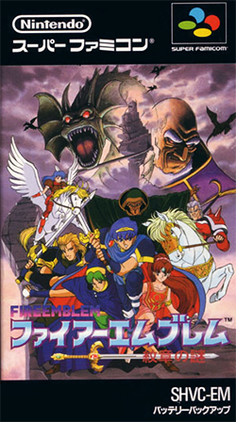
Fire Emblem: Mystery of the Emblem, known in Japan as Fire Emblem: Monshō no Nazo, is a tactical role-playing video game developed by Intelligent Systems, and published by Nintendo for the Super Famicom home video game console in 1994. It is the third installment of the Fire Emblem series, and the first to be developed for the Super Famicom. The story is divided into two parts: the first part is a retelling of Fire Emblem: Shadow Dragon and the Blade of Light, while the second is an original story acting as a sequel to the first game. After defeating the sorcerer Gharnef and the Dark Dragon Medeus, peace is restored to Archanea and Marth restores his kingdom. His ally Hardin ascends to the throne of Archanea, but begins hostile military expansion across the continent, forcing Marth to confront his old friend and the force driving him. Gameplay follows the traditional Fire Emblem system of tactical battles taking place on grid-based maps.

Super Smash Bros. Brawl is a 2008 crossover fighting game developed by Sora Ltd. and Game Arts and published by Nintendo for the Wii. The third installment in the Super Smash Bros. series, it was announced at a pre-E3 2005 press conference by Nintendo president Satoru Iwata. Masahiro Sakurai, director of the previous two games in the series, assumed the role of director at Iwata's request. Game development began in October 2005 with a creative team that included members from several Nintendo and third-party development teams. After delays due to development problems, the game was released worldwide in 2008.

Super Smash Bros. Melee is a 2001 crossover fighting video game developed by HAL Laboratory and published by Nintendo for the GameCube. It is the second installment in the Super Smash Bros. series. It features characters from Nintendo video game franchises such as Mario, The Legend of Zelda, Star Fox, Pokémon, and Donkey Kong among others. The stages and gameplay modes reference or take designs from these franchises as well.

Super Smash Bros. is a 1999 crossover fighting game developed by HAL Laboratory and published by Nintendo for the Nintendo 64. It was first released in Japan on January 21, 1999, in North America on April 26, 1999, and in Europe on November 19, 1999. The first installment in the Super Smash Bros. series, it is a crossover between several different Nintendo franchises, including Mario, The Legend of Zelda, Star Fox, Yoshi, Donkey Kong, Metroid, F-Zero, Mother, Kirby, and Pokémon. It presents a cast of characters and locations from these franchises and allows players to use each character's unique skills and the stage's hazards to inflict damage, recover health, and ultimately knock opponents off the stage.
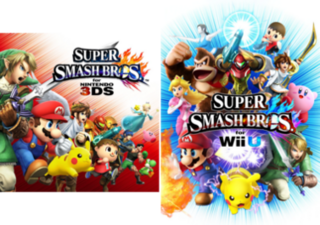
Super Smash Bros. for Nintendo 3DS and Super Smash Bros. for Wii U, both commonly referred together as Super Smash Bros. 4, are 2014 crossover platform fighter video games developed by Bandai Namco Studios and Sora Ltd. and published by Nintendo for the Nintendo 3DS and Wii U video game consoles. It is the fourth installment in the Super Smash Bros. series, succeeding Super Smash Bros. Brawl. The Nintendo 3DS version was released in Japan on September 13, 2014, and in North America, Europe, and Australia the following month. The Wii U version was released in North America, Europe, and Australia in November 2014 and in Japan the following month.
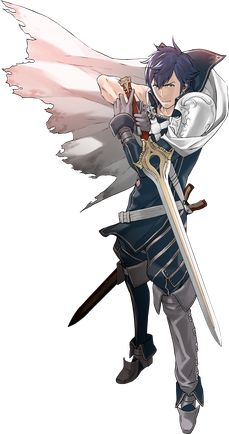
Chrom is a character in the video game Fire Emblem Awakening and its related Fire Emblem franchise. He is the prince of the Kingdom of Ylisse, a descendant of Marth, the brother of Lissa and Emmeryn, and the father of Lucina. He is in charge of the state-sponsored militia force known as The Shepherds investigating the actions of an enemy state, and wields the legendary Falchion. Chrom has also appeared in other games in the Fire Emblem series and in crossover video games such as Project X Zone 2, Tokyo Mirage Sessions ♯FE and Super Smash Bros. Ultimate. He is voiced by Tomokazu Sugita in Japanese and by Matthew Mercer in English.

Project M is a mod of the 2008 fighting game Super Smash Bros. Brawl for the Wii, created by the community group known as the Project M Development Team. It is designed to retool Brawl to play more like its two predecessors, Super Smash Bros. (1999) and Super Smash Bros. Melee (2001), in response to fan objections to Brawl's physics, slower-paced gameplay, larger use of chance elements, and mechanics of certain attacks. Project M reintroduces Dr. Mario, Mewtwo, and Roy, who were present in Melee but were cut from Brawl due to time constraints. In addition, it features a new art style for in-game menus and allows players to choose certain characters individually when they are only accessible as transformations of other ones in Brawl.
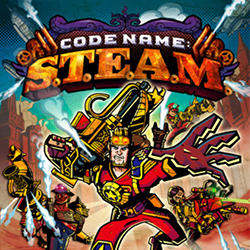
Code Name: S.T.E.A.M., known in Japan with the subtitle Lincoln vs. Aliens, is a turn-based strategy video game developed by Intelligent Systems and published by Nintendo for the Nintendo 3DS handheld game console. The story is set in an alternate steampunk-based history and features a Silver Age comic book art style and a cast of characters from across American literature and folklore. The gameplay blends turn-based strategy with third-person shooter elements in a similar vein to the Valkyria Chronicles series.

Lucina is a fictional character and one of the protagonists from Intelligent Systems's 2012 role-playing video game Fire Emblem Awakening, part of their overarching Fire Emblem series of video games. Her popularity later led to her inclusion in several other video games, including Intelligent System's 2015 title Code Name: S.T.E.A.M., Nintendo's crossover fighting game Super Smash Bros. for Nintendo 3DS and Wii U and its sequel Super Smash Bros. Ultimate, Capcom's Monster Hunter Frontier G, and Bandai Namco's crossover RPG Project X Zone 2. Lucina would again appear in future Fire Emblem titles as well, including Fire Emblem Fates, Fire Emblem Heroes, Fire Emblem Warriors, and Fire Emblem Engage though in more of a supporting role rather than a protagonist with the latter titles.

Super Smash Bros. Ultimate is a 2018 crossover fighting game developed by Bandai Namco Studios and Sora Ltd. and published by Nintendo for the Nintendo Switch. It is the fifth installment in the Super Smash Bros. series, succeeding Super Smash Bros. for Nintendo 3DS and Wii U (2014). The game follows the series' traditional style of gameplay, in which players control one of the various characters and use attacks to weaken their opponents and knock them out of an arena. It features a wide variety of game modes, including a single-player campaign and multiplayer versus modes. Ultimate features 89 playable fighters, including all characters from previous Super Smash Bros. games as well as newcomers. The roster ranges from Nintendo characters to those from third-party franchises.

Robin, also known in the game as Avatar, is a player avatar from Nintendo's Fire Emblem video game series, who first appeared in Fire Emblem Awakening as its lead character. In the story of Fire Emblem Awakening, the Avatar awakens in a grassy field and is found by Chrom and his sister Lissa, but suffers from amnesia. Despite this, Robin is a skilled fighter and serves as the main tactician in the army. Robin is the eventual parent of Morgan and the child of Validar. Following their appearance in Awakening, Robin received more widespread attention from their playable appearances, including the Super Smash Bros. series.

Byleth Eisner is a fictional character in Nintendo's Fire Emblem franchise. They first appeared as the player character and main protagonist of Fire Emblem: Three Houses (2019), and have since appeared as a playable character in the crossover games Fire Emblem Heroes (2017) and Super Smash Bros. Ultimate (2018), being added as DLC in 2019 and 2020 respectively, and as a recurring antagonist in Fire Emblem Warriors: Three Hopes (2022). In each game, players can choose between a female or male version of the character. The male version of the character also appears in Fire Emblem Engage (2023) as an Emblem alongside other Fire Emblem protagonists.
